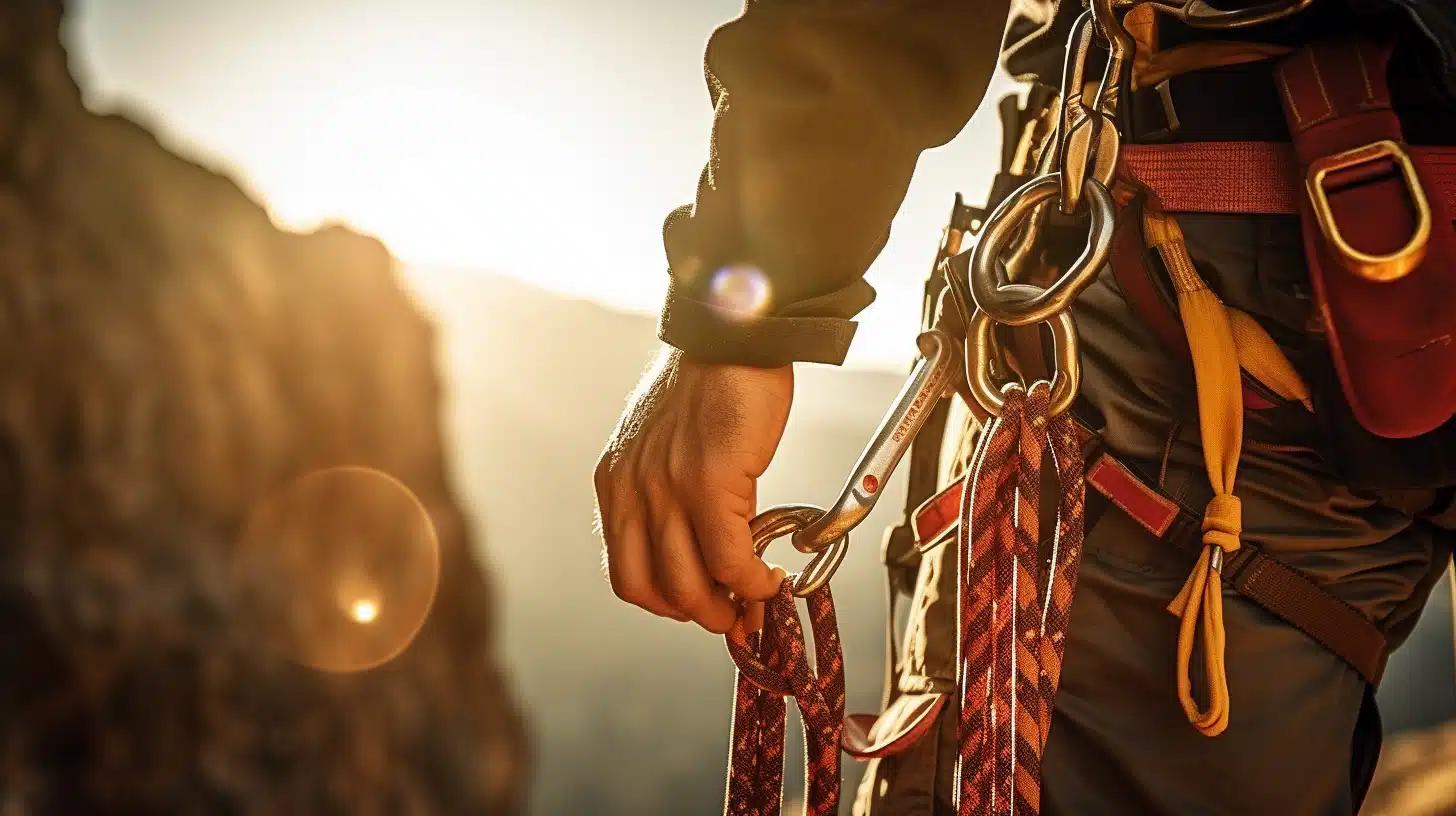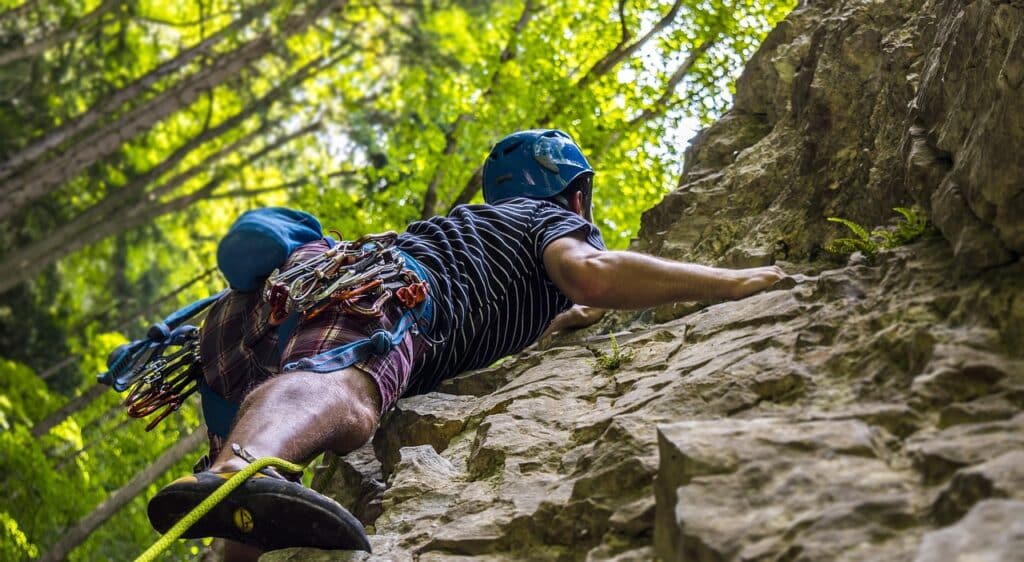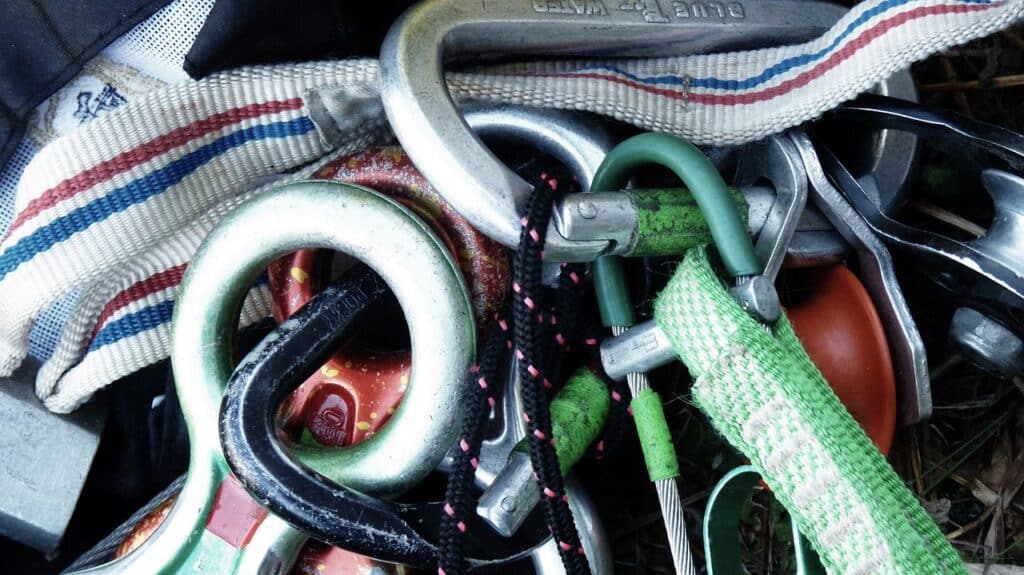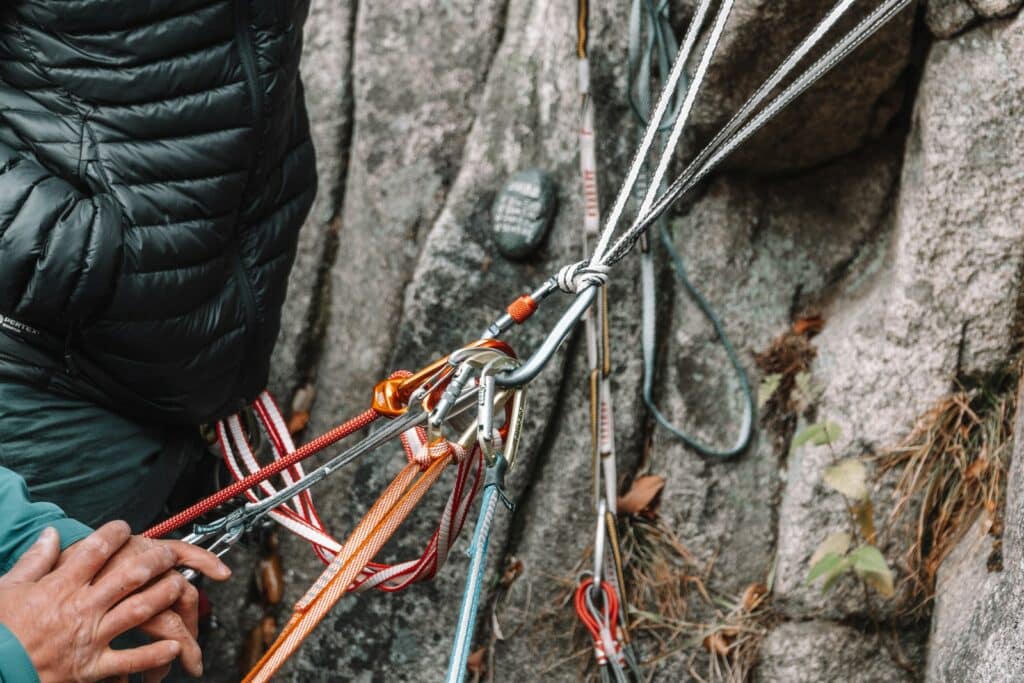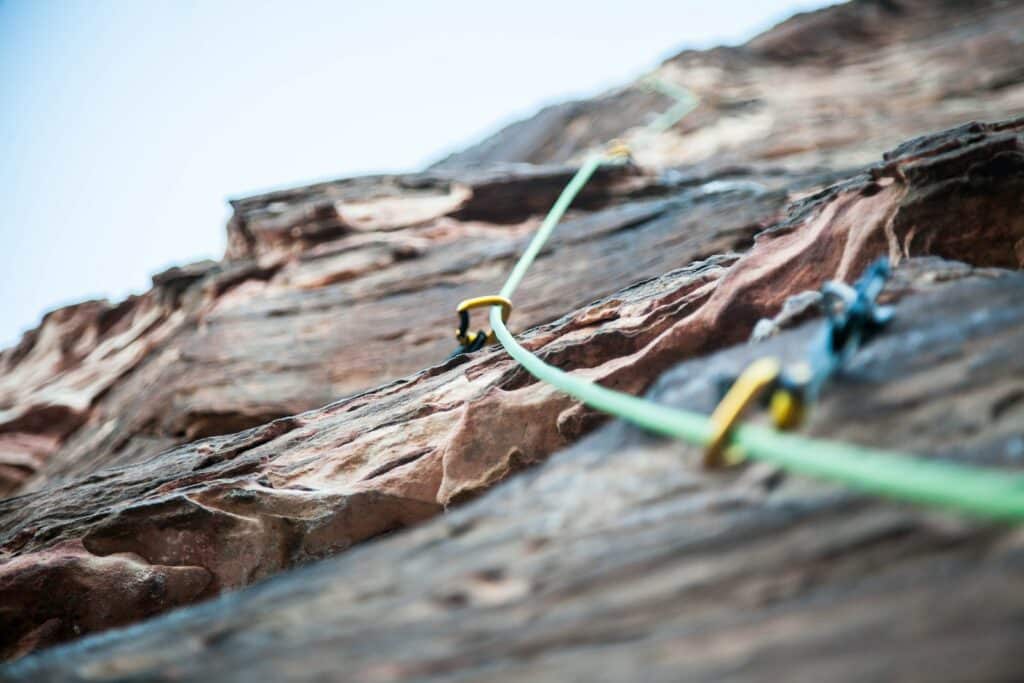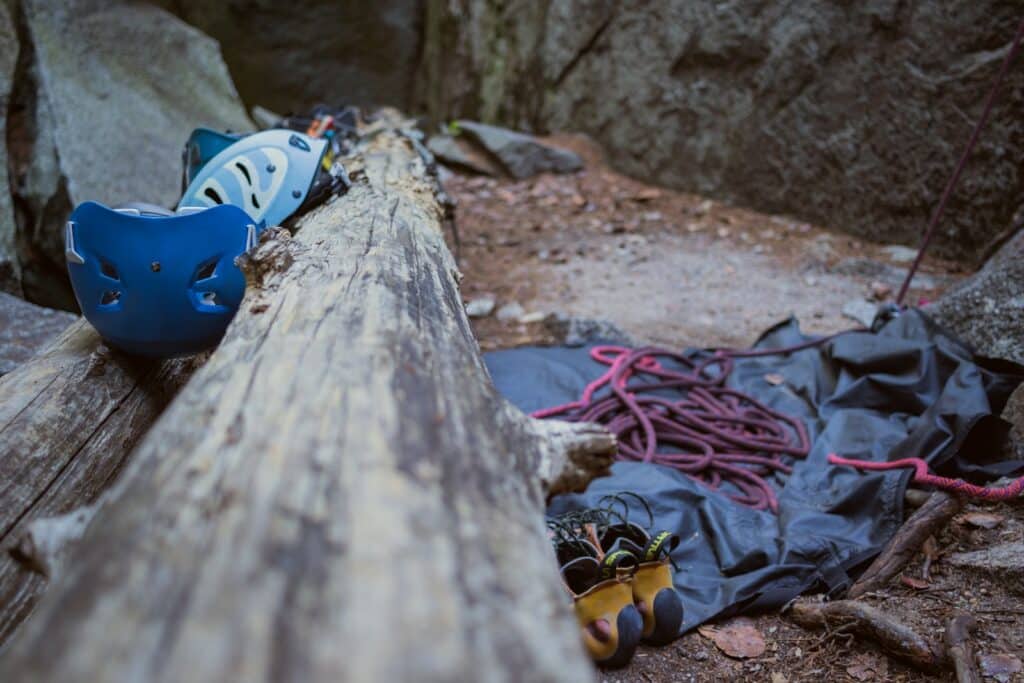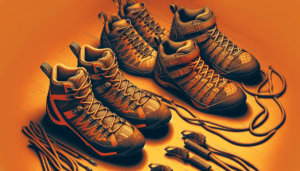Table of Contents
ToggleBasics of Trad Climbing Slings
As a budding rock climber keen to explore the world of traditional, or “trad” climbing, you’re probably eager to learn about all the gear that makes up a well-stocked trad rack. Today, let’s talk about one of the most versatile and commonly used items in trad climbing – slings.
Understanding Trad Climbing
Trad climbing, short for traditional climbing, is a style of rock climbing where climbers place all their own protection into the rock as they ascend, rather than relying on pre-placed bolts or anchors. It’s an adventurous and self-reliant form of climbing that offers a deep connection with the rock and the environment. For a detailed comparison of trad climbing with other styles, have a look at our article on trad climbing vs sport climbing.
Components of a Trad Climbing Sling
A trad climbing sling, also known as a runner, is an essential component of your trad climbing gear. Slings are used for a variety of purposes, such as building anchors, extending protection placements, and creating equalization systems (REI).
Trad climbing slings are typically made from high-quality nylon or Dyneema. Nylon is the more common choice due to its lower cost and better abrasion resistance (REI). Slings come in various lengths and widths, which you can select based on your specific climbing needs.
Slings are usually color-coded for easy identification of length, and feature a sewn loop at each end for secure attachment to other gear. They are lightweight, compact, and easy to carry on your climbing harness or in your pack.
To understand more about the different types of trad climbing gear and their uses, check out our comprehensive guide on trad climbing gear.
Remember, getting to know your gear is just the first step. The real adventure begins when you start to put your knowledge into practice on the rock. So, gear up, stay safe, and enjoy the journey!
Material Choices for Trad Climbing Slings
When you’re exploring the world of trad climbing, your gear is your lifeline. The material of your trad climbing slings is one factor you can’t overlook. The two most common materials you’ll encounter are nylon and Dyneema. Let’s take a closer look at both.
Nylon Slings
First up, we have nylon slings. These are a popular choice for many climbers because of their superior stretch capabilities and better force absorption, making them an ideal choice in the event of a fall (Outdoor Gear Lab).
In terms of strength, nylon slings are rated to hold up to 22kN (4,945 pounds) of force (REI). This strong durability, coupled with a lower cost and better abrasion resistance, makes nylon a common choice for trad climbing slings.
Dyneema Slings
On the other hand, Dyneema slings are lighter and stronger than their nylon counterparts. They offer less stretch, which can be a benefit or a drawback depending on your needs.
What’s impressive about Dyneema slings is their strength-to-weight ratio. They’re rated to hold up to 27kN (6,070 pounds) of force (REI). If you’re looking for a sling that’s lightweight but packs a punch in terms of strength, Dyneema could be the material for you.
| Material | Stretch | Strength | Weight |
|---|---|---|---|
| Nylon | High | 22kN | Heavier |
| Dyneema | Low | 27kN | Lighter |
Whichever material you choose, remember that the right sling for you depends on your specific climbing needs and preferences. So whether you’re just beginning your trad climbing journey or preparing for your next lead climbing adventure, ensure you have the right gear for the job. And remember, safety should always be your top priority. Happy climbing!
Choosing the Right Length
When selecting your trad climbing slings, one of the most important considerations is the length. The ideal length for your sling can vary depending on the specific climbing situation and the desired purpose. Let’s delve into the common lengths and how to determine the best length for your needs.
Common Lengths for Trad Climbing Slings
Trad climbing slings are available in various lengths, with the most common lengths being 24 inches (60 cm), 48 inches (120 cm), and 72 inches (180 cm) (REI). These lengths offer a good range of versatility, suitable for most climbers. However, slings can be found in lengths ranging from 30cm to 240cm, allowing for a wide range of applications.
Here’s a quick overview of the common sling lengths:
| Sling Length (inches) | Sling Length (cm) |
|---|---|
| 24 | 60 |
| 48 | 120 |
| 72 | 180 |
Deciding Factors in Choosing Length
Choosing the appropriate length for your sling depends on multiple factors. One of the key aspects to consider is the climbing situation. For example, longer slings are preferred in scenarios where you need to build anchors or extend placements. The additional length allows for more versatility and flexibility in these situations.
Your personal climbing style and the routes you intend to climb also play a role in your choice. If you frequently climb routes with large features or wide cracks, longer slings can be beneficial. On the other hand, if you’re climbing routes with closely spaced protection or smaller features, shorter slings may be more suitable.
Ultimately, the best way to decide on the length of your trad climbing slings is to consider your climbing goals, the types of routes you typically climb, and your personal preferences. It may be helpful to carry a variety of sling lengths on your trad rack. This way, you’ll be prepared for a variety of climbing scenarios and can select the most appropriate sling for the situation at hand. If you’re just starting out in trad climbing, you can also refer to our guide on trad climbing for beginners for more tips and advice.
Care and Maintenance of Trad Climbing Slings
One of the most important aspects of using trad climbing slings is ensuring they are properly cared for and maintained. This not only ensures the longevity of your gear but more importantly, your safety. Here, we’ll discuss regular inspections and the proper storage of trad climbing slings.
Regular Inspection of Slings
Regular inspection of your trad climbing slings is crucial to ensure their integrity and safety. Look for signs of wear such as fraying, cuts, or discoloration. It’s important to note that even seemingly minor damage can significantly reduce the strength of a sling, leading to potential failure.
Furthermore, even if a sling appears to be in good condition, it should be retired after it has been subjected to a significant force, such as a fall, or after a certain amount of time. This is due to the fact that the material can degrade over time, even if it’s not visibly apparent.
So, remember, always inspect your slings before and after use, and don’t hesitate to retire any gear that shows signs of wear, damage, or aging. It’s always better to be safe than sorry.
Proper Storage of Slings
In addition to regular inspections, proper storage of your trad climbing slings is critical. It’s essential to keep slings in a cool, dry place, away from direct sunlight and any chemicals. This will help to prevent degradation of the material, maintaining the structural integrity of the slings.
Furthermore, make sure your slings are clean and completely dry before storage. Any moisture can lead to the growth of mold and mildew, which can weaken the material.
Remember, your trad climbing gear is an investment in your safety. Proper care, regular inspection, and suitable storage practices are key to maintaining the performance and lifespan of your trad climbing slings.
For more tips on trad climbing gear maintenance and safety, check out our articles on trad climbing safety.
Application of Trad Climbing Slings
Trad climbing slings are a versatile tool in your trad climbing gear arsenal. There are several ways you can use them during your climb. In this section, we’ll cover two common applications: slinging blocks and flakes, and threading slings.
Slinging Blocks and Flakes
One of the most common uses of slings is to extend or equalize gear, either on lead or at the belay, but they can also be used as protection by themselves (VDiff Climbing). The most common features to ‘sling’ are blocks and flakes. Slings can be placed over the feature and clipped to the rope with a carabiner, or tied as a clovehitch around the feature to reduce the chance of it being lifted off during climbing.
When placing a sling, I always make sure to give it a gentle pull in the direction of loading and wiggle it around. This simulates how it may be pulled in a fall or by movements in the rope while climbing above. This simple step can provide extra assurance that your sling is secure and ready to provide protection.
Threading Slings
Another application of trad climbing slings is threading. This is when you poke the sling through a hole or behind a feature. To thread a sling, simply poke it through the hole, pull it until both ends are even, and then clip a quickdraw to it (VDiff Climbing).
Threading slings can be a useful technique when climbing routes with natural holes, threads or ‘chickenheads. This method can provide a secure point of protection and often leaves no trace on the rock, making it a popular choice for environmentally conscious climbers.
Whether you’re slinging blocks and flakes or threading slings, it’s important to always double-check your gear placements. Trad climbing is a serious sport that requires a strong understanding of your trad climbing gear, including trad climbing slings. If you’re new to trad climbing, consider checking out our trad climbing for beginners guide. Stay safe and enjoy your climb!
Safety Considerations in Trad Climbing
Safety is paramount in all forms of climbing, and that’s no different when it comes to using trad climbing slings. From strength ratings to knowing when to retire your gear, let’s explore these key factors.
Strength Rating of Slings
The strength rating of a sling is a crucial consideration. It essentially tells you how much force the sling can withstand before it breaks. According to Outdoor Gear Lab, trad climbing slings should have a strength rating of at least 22kN to ensure sufficient safety when used for protection or anchoring.
Depending on the material, different slings can handle different levels of force. For instance, Nylon slings are rated to hold up to 22kN (4,945 pounds) of force, while Dyneema slings, with a higher strength-to-weight ratio, are rated to hold up to 27kN (6,070 pounds) of force (REI).
| Material | Strength Rating (kN) | Strength Rating (Pounds) |
|---|---|---|
| Nylon | 22 | 4,945 |
| Dyneema | 27 | 6,070 |
Remember, though, that these ratings are based on new, undamaged slings. Any wear and tear can significantly decrease a sling’s strength rating.
Retiring and Replacing Slings
Just like any other piece of safety gear, slings don’t last forever. It’s recommended to retire climbing slings after they have been subjected to a significant force or after a certain amount of time, even if they appear to be in good condition (REI).
Signs that a sling needs to be retired include visible damage like fraying, discoloration, or cuts. Additionally, if a sling has been subjected to a high-force event like a severe fall, it should be retired immediately.
As a general rule, even if a sling shows no visible signs of wear, it should be retired after 5 years of regular use or 10 years from the date of manufacture, whichever comes first. However, always follow the manufacturer’s specific guidelines for each sling.
Remember, no climb is worth risking your safety. Regularly inspecting and replacing your trad climbing gear is a small price to pay for the peace of mind it brings. Stay safe out there!

